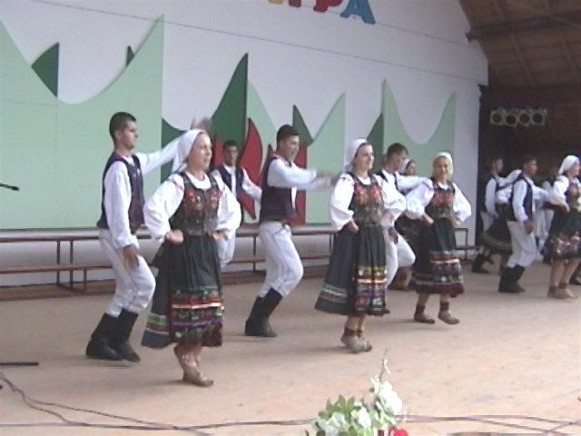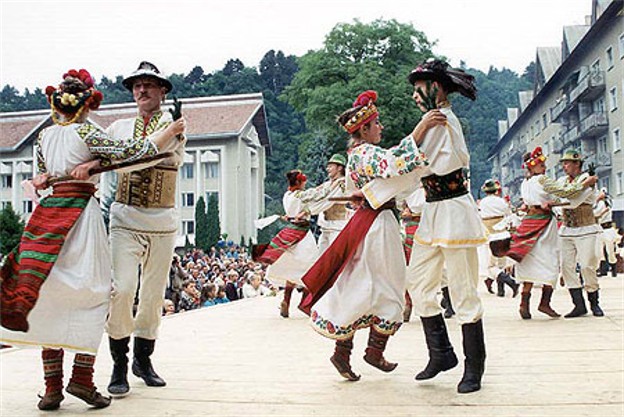Folk dance
Folk dance. In prehistoric and ancient times dance was a ritual means of communicating with nature and the divine forces. Only isolated elements of ancient folk calendar ritual and cult dances have survived through the centuries. With the introduction of Christianity in Ukraine (see Christianization of Ukraine), the archaic relics of these dances blended with Christian rituals and were adapted to the church calendar and Christian festivals. Certain mentions of ancient dances can be found in written sources, but the largest number of them can be found in ancient Ukrainian folk songs. The oldest Slavic word for the dance is plias; the modern word tanets was borrowed from West European languages.
Ancient Ukrainian dances were actually agricultural dance games (khorovody; see Khorovod); their basic form was the circle, associated with the cult of the sun, the greatest life-giving power. The most widely known are the spring khorovody (circular choral dances), such as kryvyi tanets, podolianochka, perepilka, yahilochka, and verbova doshchechka. In time, the vesnianky-hahilky were enriched by new themes, and some of them conveyed the image of life under serfdom (zelman, bondarivna, and others). In general, the vesnianky-hahilky have a lyrical character; their movements are gentle, tranquil, and restrained.
In the summer the dances of the Kupalo festival, which was probably connected with the pre-Christian feast of Rusalii, were performed. In the Hutsul region, on the eve of Saint George's day, girls performed a ritual dance called lelia, which was reminiscent of the old Roman festival of roses (dies rosae, rosalia, rosatio) and invoked the happiness of love. Dances were also performed during the Whitsuntide celebrations (see Pentecost). In the late summer and early autumn the harvest feast (obzhynky) was celebrated by circular dances (obzhynkovi khorovody), which constituted a dramatization of the song content and an imitation of agricultural work (see Harvest rituals). The harvest circular songs (see Harvest songs) were performed mainly by women, and the scything ones by men. The pre-Lenten carnival period (miasnytsi) was also the time for weddings, which have in part preserved the traditional ritual character of dance. The carnival dances are performed primarily by women. Such dances as podushkovyi, kocherha, and stilchyk are mimetic representations of the wedding songs. The wedding dances are similar in certain respects to the ancient funeral dances.
Ukrainian ritual dances are performed mostly to the accompaniment of a churchlike, antiphonic chant. They are rarely performed to music. The chorals most typical of these dances are supplicative and commemorative in nature. The ritual folk dance has been little studied. It is presumed that the separation of song and dance began during the early Middle Ages, as the ancient cult rites became divided with the introduction of Christianity. One part was retained in the form of folk dancing; the other was taken over by professional dancers, who replaced the song in the dance with mime. Dance became a form of pure entertainment. New types of traveling dancers (the skomorokhy) appeared. They performed their art in squares or in palaces, where they entertained the princes and nobles.
Ukrainian folk dances can be divided into two groups: those performed to the accompaniment of songs and those performed to music. Musical instruments (husli, flutes, horns, tsymbaly, kobza, and others [see Folk musical instruments]) were introduced later as a means of maintaining the rhythm of the dance. The dances are classified as circular and topical, the latter including dances that reflect folkways, occupational and humorous dances, and others. The majority of Ukrainian folk dances closely resemble the circular dance types but are enriched by figurative intricacies; the pair and solo dances evolved from this type. Their structure is linear, even geometrical, showing a tendency towards imaginative patterns (circle, cross, serpent, chain, rows, and others), spatiality, and rounded lines. They unfold in a horizontal direction, except for the vertical dances of the mountain peoples. The circular dances are accompanied by a song. The choreographic image depends on the song's content. These dances contain many ancient elements and are ritually allegoric or symbolic, but their technique is somewhat poorer because, as group dances, they are subordinated to one leading performer.
Through their movements, gestures, and type of music, the topical dances portray events that occur in nature or in everyday life. While they have a variety of steps and figures, their content is simple. Performed to a song that has a 2/4 musical beat, they are based on one or two steps, are quite diverse in composition, and are arranged in an orderly and successive manner. The dances that are most popular today in Ukraine are those that portray the people's way of life. They are performed at weddings, dances, parties, and so on.
Performed originally by females only, the following dances are now performed by men and women: metelytsia, Kateryna, Vasylykha, dribushka, horlytsia, volynianka, and tropotianka. At one time exclusively men's dances, the following are now also performed as male-female pair, group, or solo dances: chumak, hopak, chaban, veselyi, vivchar, ocheret, zaporozhets, kozachok, and arkan. The kolomyika, popular in Western Ukraine and performed with a variety of steps (holubka, merezhka) to the accompaniment of dialogue-type songs, is reminiscent of the ancient circular dances and has a 2/4 musical beat. Ukraine's historic past is reflected in men's dances, for example, the Gonta, which symbolizes heroism, manliness, and patriotism. The hopak, which features physical strength and almost acrobatic agility, has, in time, become transformed into a pair or group dance. Its theme is a youth's wooing of a girl. The youth executes ingenious leaps, kicks, and squats in order to gain the girl's favor. The theme of labor finds expression in such topical dances as kravchyk, shevchyk, lisoruby, and kovali; various movements in these dances convey the intricacies of a trade or occupation and the dexterity of the artisan. There are also humorous dances (eg, bychky, husak, kozlyk, and others) that depict the behavior of animals and birds.
Podlachian folk dances (eg, haiduk, kozak, shatalier) have retained most of their ancient elements. In Slobidska Ukraine such ancient dances as dudochka, horlytsia, and zaveriukha have been preserved, and in southern Ukraine there are still traces of the old Cossack dances (eg, zaporozhets). Lemko folk dances (eg, koshychok, kolechko, obertas, kyvanyi, Dzhurylo, and striasuvanets) have preserved some ancient elements, but they have been influenced considerably by Slovak folk culture. Transcarpathian folk dances have movements not know elsewhere in Ukraine.
Because of their recurring motifs, Ukrainian folk dances, like those of other peoples of the world, appear as a whole to be slightly repetitious in presentation. Yet, even though they do have many common elements, they vary by region in choreographic method, content, and dynamics. Ukrainian folk dances, unlike those of other peoples, were not affected strongly by court dances. Therefore they preserved their virtuosity and originality for a longer period of time. It should be emphasized that the female in Ukrainian folk dances has a dignified role: she dances gracefully and behaves modestly; she may at times act flirtatiously, but she always expresses her feelings in a restrained manner. The esthetic beauty and originality of the Ukrainian folk dances are augmented by the colorful folk costumes of the dancers and the melodic musical accompaniment.
Since the 1950s, with the growth of professional and amateur dance troupes in Ukrainian SSR and later, in Ukraine, a greater repertoire of folk dances, based both on traditional folk culture and on new choreographic improvisations, has been created. The dances reflect history (zaporozhtsi), a former folkway (chumatski radoshchi), contemporary rural life (na kukurudzianomu poli, kolhospna polka, kolhospne vesillia, novorichna metelytsia), or contemporary industrial life (shakhtiarskyi sviatkovyi).
BIBLIOGRAPHY
Lysenko, M. Molodoshchi: Zbirnyk tankiv ta vesnianok (Kyiv 1875)
Famintsyn, A. Skomorokhy na Rusi (Saint Petersburg 1889)
Hnatiuk, V. ‘Kolomyiky,’ Etnohrafichnyi zbirnyk NTSh (Lviv 1905)
Verkhovynets', V. Teoriia ukraïns’koho narodnoho tanka (Poltava 1920)
Baryliak, O. Iahilky (Lviv 1932)
Avramenko, V. Ukraïns’ki narodni tanky, muzyka i strii (Winnipeg 1941)
Tkachenko, T. Ukraïns’ki narodni tantsi (Kyiv 1955)
Humeniuk, A. (ed). Ukraïns’ki narodni tantsi (Kyiv 1962)
Pasternakova, M. Ukraïns’ka zhinka v khoreohrafiï (Winnipeg 1963)
Boryms’ka, H. Samotsvity ukraïns’koho tantsiu (Kyiv 1974)
Mariia Pasternak
[This article originally appeared in the Encyclopedia of Ukraine, vol. 1 (1984).]


